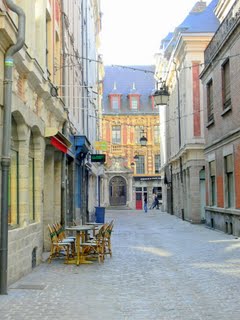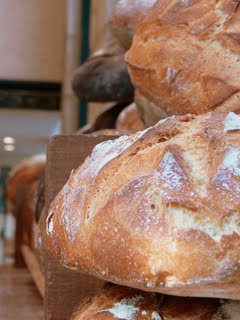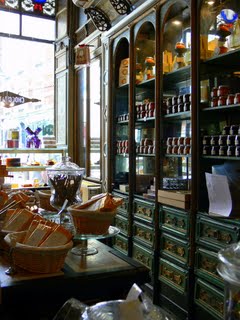 The nice folks at Eurostar and Little Break, Big Difference invited me and a gaggle of other food bloggers to come with them to Lille for a day of foodie tourism. The basic idea here seems to be to demonstrate that destinations like Lille are so close to London that you can hop on a train in the morning, fill a day with Gallic excitement, and then pop back home on that same train in the evening. Once you’re at St Pancras, you’re less than an hour and a half from Lille – and Lille’s station is under five minutes’ walk from the old town centre, so there’s really very little excuse for my not having been before. It’s also, at around £60 a return ticket, far cheaper than I’d realised.
The nice folks at Eurostar and Little Break, Big Difference invited me and a gaggle of other food bloggers to come with them to Lille for a day of foodie tourism. The basic idea here seems to be to demonstrate that destinations like Lille are so close to London that you can hop on a train in the morning, fill a day with Gallic excitement, and then pop back home on that same train in the evening. Once you’re at St Pancras, you’re less than an hour and a half from Lille – and Lille’s station is under five minutes’ walk from the old town centre, so there’s really very little excuse for my not having been before. It’s also, at around £60 a return ticket, far cheaper than I’d realised.
 And if you’re the sort of person for whom a day’s food shopping, hunting for French tableware, tasting nibbly bits, soaking up atmosphere and dabbling at cookery lessons sounds just about perfect, you could do a lot worse than emulate the day’s itinerary that was organised for us, perhaps with a slightly later start and an evening meal in France (we left London at 7am, which meant a 5am start for lots of us, and returned before supper time). I don’t usually enjoy pre-organised, structured tourism (I get a lot of pleasure out of organising and planning things myself and get depressingly snobbish about guided tours and package holidays). Fortunately the company was so good and the city so packed with interesting food and drink – breakfast, a lunch cooked by the group at l’Atelier des Chefs, a cheese and beer tasting and an awful lot of pâtisseries – that I found myself enjoying being in something that would have felt a bit like a tour group if everybody hadn’t been quite so single-mindedly seeking out and photographing food.
And if you’re the sort of person for whom a day’s food shopping, hunting for French tableware, tasting nibbly bits, soaking up atmosphere and dabbling at cookery lessons sounds just about perfect, you could do a lot worse than emulate the day’s itinerary that was organised for us, perhaps with a slightly later start and an evening meal in France (we left London at 7am, which meant a 5am start for lots of us, and returned before supper time). I don’t usually enjoy pre-organised, structured tourism (I get a lot of pleasure out of organising and planning things myself and get depressingly snobbish about guided tours and package holidays). Fortunately the company was so good and the city so packed with interesting food and drink – breakfast, a lunch cooked by the group at l’Atelier des Chefs, a cheese and beer tasting and an awful lot of pâtisseries – that I found myself enjoying being in something that would have felt a bit like a tour group if everybody hadn’t been quite so single-mindedly seeking out and photographing food.
 It’s August, so northern France has emptied out. Lille was wonderfully quiet, especially before 10am, when the shops opened, giving us a great opportunity to take some pictures of a quiet, sunny city. We started with a spot of pâtisserie and chocolate shopping; this bread is from Aux Merveilleux de Fred (67 rue de la Monnaie), where fez-sized meringue merveilleuxes, sandwiched together with a dollop of buttercream and encased in chocolate, were also being prepared. (Sadly, a fez-sized meringue does not travel well, so Fred’s merveilleuxes remain unsampled – if you can visit in the morning you’ll have a very enjoyable few minutes watching them being made through the window.) We did buy a baguette here to sample as soon as the shop opened, and it was excellent in the way only something this fresh can be, with a crackling crust, a soft and yeasty crumb, and a total refusal to fit comfortably in anyone’s bag. We then overwhelmed the poor staff at Patrick Hermand (Rue Basse), a modern pâtisserie in a tiny lacquered box of a room, where about twenty varieties of macarons were on offer, alongside these joyous pâtisseries. Note – what you are seeing here is cakes with macarons embedded in them. A large box of macarons came home with me.
It’s August, so northern France has emptied out. Lille was wonderfully quiet, especially before 10am, when the shops opened, giving us a great opportunity to take some pictures of a quiet, sunny city. We started with a spot of pâtisserie and chocolate shopping; this bread is from Aux Merveilleux de Fred (67 rue de la Monnaie), where fez-sized meringue merveilleuxes, sandwiched together with a dollop of buttercream and encased in chocolate, were also being prepared. (Sadly, a fez-sized meringue does not travel well, so Fred’s merveilleuxes remain unsampled – if you can visit in the morning you’ll have a very enjoyable few minutes watching them being made through the window.) We did buy a baguette here to sample as soon as the shop opened, and it was excellent in the way only something this fresh can be, with a crackling crust, a soft and yeasty crumb, and a total refusal to fit comfortably in anyone’s bag. We then overwhelmed the poor staff at Patrick Hermand (Rue Basse), a modern pâtisserie in a tiny lacquered box of a room, where about twenty varieties of macarons were on offer, alongside these joyous pâtisseries. Note – what you are seeing here is cakes with macarons embedded in them. A large box of macarons came home with me.



 On to Meert (27, Rue Esquermoise), a pâtisserie and restaurant opened in 1761, where we sampled deceptively slim and delicate waffles in the beautiful baroque dining room at the back of the shop. They might be slim, but these waffles or gauffres are, unusually, stuffed with an incredibly dense buttercream spiked with flecks of vanilla, and at this time in the morning I could only manage one, praying inbetween bites that death from an overwhelmed gall bladder would wait until I was finished. A photograph of me enjoying a waffle a little bit too much has been put on Flickr by the ladies from Little Break, Big Difference. Note that I’ve only managed one mouthful so far in the picture. Merveilleuxes were available here too, and we split one between four, helped down with some scented, fruity iced tea and a few gallons of coffee. Shopping at Meert is well worth your time even if you don’t choose to sit down for a bite to eat; you’ll find all kinds of pâtisseries, caramels, fruit jellies, chocolates, miniature waffles and some excellent teas and coffees.
On to Meert (27, Rue Esquermoise), a pâtisserie and restaurant opened in 1761, where we sampled deceptively slim and delicate waffles in the beautiful baroque dining room at the back of the shop. They might be slim, but these waffles or gauffres are, unusually, stuffed with an incredibly dense buttercream spiked with flecks of vanilla, and at this time in the morning I could only manage one, praying inbetween bites that death from an overwhelmed gall bladder would wait until I was finished. A photograph of me enjoying a waffle a little bit too much has been put on Flickr by the ladies from Little Break, Big Difference. Note that I’ve only managed one mouthful so far in the picture. Merveilleuxes were available here too, and we split one between four, helped down with some scented, fruity iced tea and a few gallons of coffee. Shopping at Meert is well worth your time even if you don’t choose to sit down for a bite to eat; you’ll find all kinds of pâtisseries, caramels, fruit jellies, chocolates, miniature waffles and some excellent teas and coffees.
 A brisk trot through town, giving us a chance to enjoy the sunny morning, to a cookery class at l’Atelier des Chefs. If I’d been planning the day myself, there’s absolutely no way I’d have been involved in cooking my own lunch, but if you are the sort of person who enjoys casual classes and an introduction to local produce a
A brisk trot through town, giving us a chance to enjoy the sunny morning, to a cookery class at l’Atelier des Chefs. If I’d been planning the day myself, there’s absolutely no way I’d have been involved in cooking my own lunch, but if you are the sort of person who enjoys casual classes and an introduction to local produce a
nd flavours, you might want to look into a session here. (L’Atelier also runs classes in London and many other cities – check their UK website for details.) Divided into groups of four and clad in very swanky Eurostar-branded aprons, we had a quick drink in a room full of kitchen equipment for sale. Once in the kitchen, we were talked through the preparation of tiramisu made with speculoos, the delicious caramel and cinnamon biscuits you’ll find served alongside coffee in these parts; then we prepared cod flambéed in honey and fleur de bière, a hoppy, floral eau de vie distilled from beer. A pleasant but not fabulous meal (the honey/fleur de bière sauce made for a very unbalanced, candied flavour profile which doesn’t sit well with cod) – and once we were perched on stools to eat our meal at a table surrounded by shelves and shelves of more expensive merchandise, I found myself wishing we’d gone to L’Huîtrière in the old town instead. But I am an avowed grump who does a lot of cooking – as you are doubtless of a sunnier disposition, your mileage may vary.
 We were met at Le Capsule (25 Rue des 3 Molettes), a fantastically atmospheric little bar full of French emo kids, by Aymeric Gillet-Chevais, the president and founder of ATPUB, the French version of CAMRA. Down in the damp (and very dark, so I’m showing you a picture of the town square instead) cellar, he talked us through French beer culture, and told us about the different producers. The bar is not tied to a specific brewery (unlike a shocking 99% of French bars), so you’ll find 130 beers on the list from minuscule breweries, many very close to Lille itself. We worked our way through four beers; I particularly liked Page 24, from a small brewery 35km outside the city. Chicory is a common addition to northern French beers, says Aymeric, who must have France’s very best name; and this blonde beer packs a bitter punch, rounded off with a lovely coriander nose. Four local cheeses from Philippe Olivier (3, Rue Curé St Etienne) were served too, and it is to my eternal misery that a family emergency had closed the shop for the afternoon, because I would have murdered for a slab of the Maroilles we ate to take home.
We were met at Le Capsule (25 Rue des 3 Molettes), a fantastically atmospheric little bar full of French emo kids, by Aymeric Gillet-Chevais, the president and founder of ATPUB, the French version of CAMRA. Down in the damp (and very dark, so I’m showing you a picture of the town square instead) cellar, he talked us through French beer culture, and told us about the different producers. The bar is not tied to a specific brewery (unlike a shocking 99% of French bars), so you’ll find 130 beers on the list from minuscule breweries, many very close to Lille itself. We worked our way through four beers; I particularly liked Page 24, from a small brewery 35km outside the city. Chicory is a common addition to northern French beers, says Aymeric, who must have France’s very best name; and this blonde beer packs a bitter punch, rounded off with a lovely coriander nose. Four local cheeses from Philippe Olivier (3, Rue Curé St Etienne) were served too, and it is to my eternal misery that a family emergency had closed the shop for the afternoon, because I would have murdered for a slab of the Maroilles we ate to take home.
We had about twenty minutes before having to dash for the train, so I visited La Capsule’s sister shop, l’Abbaye des Saveurs and stocked up on beers and some other local goodies. Happily for all those of us in the EU, the shop also has an e-commerce arm. Homeware shops, cookware shops and delicatessens proliferate all the way round the old town, so you should be able to find some foodie bits and pieces to take home (save this for the end of the afternoon – if you’re only around for a day, you’ll be doing a lot of walking and this is no fun with four litres of beer, a camera and a bushel of macarons in your bag) no matter how little time you have.
You’ll find more about the day on the blogs listed at the top of the post, and video and more pictures have been unleashed on the Internet by the Little Break Big Difference ladies. I have to admit, I’m not too sure what went on on the train on the way home. I fell asleep.
There are occasions on which a roast potato will not do. (I’ll admit that these occasions are few.) For those days, these game chips are very easy to make, deliciously crispy, and packed with flavour from crispy garlic, crushed chillies, and plenty of fresh oregano.
